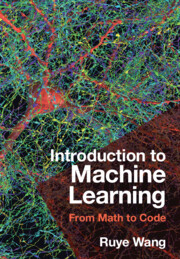Refine search
Actions for selected content:
166 results

Introduction to Machine Learning
- From Math to Code
- Coming soon
-
- Expected online publication date:
- January 2026
- Print publication:
- 18 December 2025
-
- Textbook
- Export citation
Network games with local correlation and clustering
-
- Journal:
- Network Science / Volume 13 / 2025
- Published online by Cambridge University Press:
- 12 December 2025, e24
-
- Article
-
- You have access
- Open access
- HTML
- Export citation
1 - Introduction: A First Data Science Problem
-
- Book:
- Mathematical Methods in Data Science
- Published online:
- 04 November 2025
- Print publication:
- 30 October 2025, pp 1-66
-
- Chapter
- Export citation
What can we learn from 1,000 meta-analyses across 10 different disciplines?
-
- Journal:
- Research Synthesis Methods ,
- Published online by Cambridge University Press:
- 02 October 2025, pp. 1-34
-
- Article
-
- You have access
- Open access
- HTML
- Export citation
An unsupervised information-theoretic approach to identifying formulaic clusters in textual data
- Part of
-
- Journal:
- Computational Humanities Research / Volume 1 / 2025
- Published online by Cambridge University Press:
- 19 September 2025, e9
-
- Article
-
- You have access
- Open access
- HTML
- Export citation
6 - Applications for a Single Network
- from Part III - Applications
-
- Book:
- Hands-On Network Machine Learning with Python
- Published online:
- 23 September 2025
- Print publication:
- 18 September 2025, pp 259-310
-
- Chapter
- Export citation
The Rational Partisan
-
- Journal:
- Canadian Journal of Philosophy , FirstView
- Published online by Cambridge University Press:
- 09 September 2025, pp. 1-11
-
- Article
- Export citation
6 - Discrete and Continuous Variables
-
- Book:
- Probability and Statistics for Data Science
- Published online:
- 19 June 2025
- Print publication:
- 03 July 2025, pp 202-240
-
- Chapter
- Export citation
Identification of Factor Scores by Regression with External Variables in Exploratory Factor Analysis
-
- Journal:
- Psychometrika / Volume 90 / Issue 3 / June 2025
- Published online by Cambridge University Press:
- 16 June 2025, pp. 1097-1110
-
- Article
-
- You have access
- Open access
- HTML
- Export citation
Germplasm characterization of Indian avocados based on morphological and biochemical traits
-
- Journal:
- Plant Genetic Resources / Volume 23 / Issue 5 / October 2025
- Published online by Cambridge University Press:
- 16 June 2025, pp. 363-372
-
- Article
- Export citation
3 - Phase classification
-
- Book:
- Machine Learning in Quantum Sciences
- Published online:
- 13 June 2025
- Print publication:
- 12 June 2025, pp 47-75
-
- Chapter
- Export citation
Statistical models for improved insurance risk assessment using telematics
-
- Journal:
- British Actuarial Journal / Volume 30 / 2025
- Published online by Cambridge University Press:
- 26 May 2025, e16
-
- Article
-
- You have access
- Open access
- HTML
- Export citation
Chapter 14 - Future Applications of Flow Cytometry and Related Techniques
-
-
- Book:
- Multiparameter Flow Cytometry in the Diagnosis of Hematologic Malignancies
- Published online:
- 30 January 2025
- Print publication:
- 20 February 2025, pp 219-232
-
- Chapter
- Export citation
Comparing the semantic structures of lexicon of Mandarin and English
-
- Journal:
- Language and Cognition / Volume 17 / 2025
- Published online by Cambridge University Press:
- 09 January 2025, e10
-
- Article
-
- You have access
- Open access
- HTML
- Export citation
Tucker2 Hierarchical Classes Analysis
-
- Journal:
- Psychometrika / Volume 69 / Issue 3 / September 2004
- Published online by Cambridge University Press:
- 01 January 2025, pp. 375-399
-
- Article
- Export citation
The Conjunctive Model of Hierarchical Classes
-
- Journal:
- Psychometrika / Volume 60 / Issue 4 / December 1995
- Published online by Cambridge University Press:
- 01 January 2025, pp. 505-521
-
- Article
- Export citation
A Tabu-Search Heuristic for Deterministic Two-Mode Blockmodeling of Binary Network Matrices
-
- Journal:
- Psychometrika / Volume 76 / Issue 4 / October 2011
- Published online by Cambridge University Press:
- 01 January 2025, pp. 612-633
-
- Article
- Export citation
Spatial, Non-Spatial and Hybrid Models for Scaling
-
- Journal:
- Psychometrika / Volume 41 / Issue 4 / December 1976
- Published online by Cambridge University Press:
- 01 January 2025, pp. 439-463
-
- Article
- Export citation
U-Statistic Hierarchical Clustering
-
- Journal:
- Psychometrika / Volume 43 / Issue 1 / March 1978
- Published online by Cambridge University Press:
- 01 January 2025, pp. 59-67
-
- Article
- Export citation
Bayesian Mixture Model of Extended Redundancy Analysis
-
- Journal:
- Psychometrika / Volume 87 / Issue 3 / September 2022
- Published online by Cambridge University Press:
- 01 January 2025, pp. 946-966
-
- Article
- Export citation
